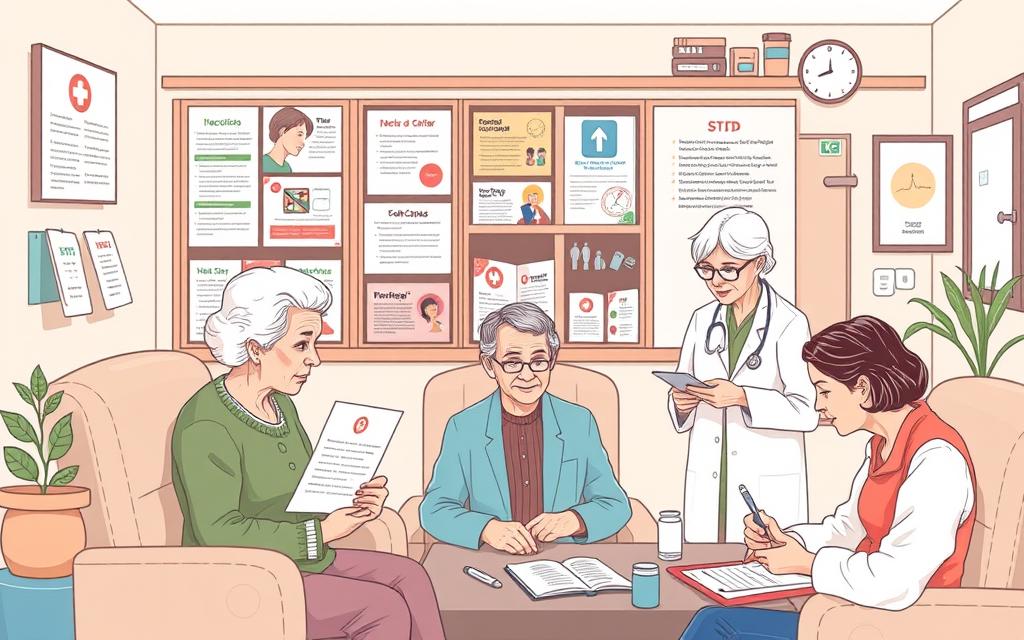Sexually Transmitted Diseases in Nursing Homes
Sexually Transmitted Diseases in Nursing Homes: We are witnessing a concerning trend in the United States. Among adults 65 or older have more than doubled Sexual transmitted Infections (STIs) in the last decade. This rise is attributed to various factors, including increased sexual activity in senior-living facilities, low condom use, and a lack of knowledge about STIs.

According to CDC data, cases of chlamydia, gonorrhea, and syphilis have seen a significant surge among adults aged 65 and older between 2010 and 2023. This issue, though often overlooked, has a substantial impact on the health and quality of life of older adults residing in nursing homes.
Key Takeaways
- Rising STI rates among older adults in the U.S.
- Significant increase in chlamydia, gonorrhea, and syphilis cases
- Factors contributing to the rise include increased sexual activity and low condom use
- The issue is often taboo, affecting resident health and quality of life
- Education, prevention, and medical intervention are crucial
- How to insert pennis into vegina? A perfect guide to sex
- Sexual Health Information for Your Well-being
The Rising Epidemic of STDs Among Older Adults
Older adults are increasingly being affected by sexually transmitted diseases, a trend that warrants immediate attention. The rates of syphilis, gonorrhea, and chlamydia have more than doubled among those aged 55 or older over the past decade.
This alarming trend is not limited to any specific age group within the older adult population. For those aged 65 and older, the situation is particularly dire, with chlamydia cases more than tripling, gonorrhea cases increasing sixfold, and syphilis cases soaring nearly tenfold between 2010 and 2023.
Current Statistics and Trends
The statistics on STDs among older adults are stark. A study of health insurance claims revealed that STIs rose nearly 24% in the 65-or-older group during the COVID-19 public health emergency, with human papillomavirus (HPV) seeing the largest increase.
| STD | Increase Among 65+ Years Old | Time Period |
|---|---|---|
| Chlamydia | More than tripled | 2010-2023 |
| Gonorrhea | Increased sixfold | 2010-2023 |
| Syphilis | Nearly tenfold increase | 2010-2023 |
| HPV | Largest increase during COVID-19 | During COVID-19 public health emergency |
These trends highlight the need for increased awareness and preventive measures among older adults, as well as the importance of regular STD screening.
- Comprehensive statistical data shows a dramatic increase in STD rates among adults over 65.
- The prevalence of specific infections like chlamydia, gonorrhea, syphilis, HIV, herpes, and HPV is on the rise.
- STD rates in nursing home residents versus community-dwelling older adults show unique risks.
Sexual Activity in Later Life: Breaking the Stigma
The notion that older adults are asexual is being challenged by growing evidence of continued sexual activity in later life. As we age, our sexual health needs evolve, and it’s essential to acknowledge and address these needs. Recent surveys and studies have provided valuable insights into the sexual activity of older adults, highlighting the importance of this aspect of their wellbeing.

Prevalence of Sexual Activity Among Older Adults
Research has shown that a significant proportion of older adults remain sexually active. According to a 2018 AARP survey, about 40% of people aged 65-80 are sexually active, and nearly two-thirds of older adults are interested in sex. More recent data from AARP found that 26% of 60- to 69-year-olds had sex weekly, as did 17% of those 70 or older.
- Approximately 40% of people aged 65-80 remain sexually active.
- Medical advances like erectile dysfunction medications and hormone replacement therapies have extended sexual activity into later years.
- The baby boomer generation has brought changing attitudes about sexuality into their senior years.
These statistics underscore the need to break the stigma surrounding sexual activity in later life and to recognize the diverse sexual health needs of older adults.
Sexually Transmitted Diseases in Nursing Homes: A Growing Concern
The prevalence of sexually transmitted diseases (STDs) in nursing homes is a growing concern that requires immediate attention. Nursing home residents face unique challenges, and although they move into these facilities to receive ongoing care and daily living activity assistance, exposure to additional health concerns can turn the nursing home experience into a nightmare.
Older adults in nursing homes are often more sexually active than most people think. Unfortunately, this can lead to the spread of STDs from resident to resident. The intimate lives of nursing home residents are often overlooked, and this lack of awareness can contribute to the rising epidemic of STDs.

Unique Risk Factors in Residential Facilities
Nursing home residents face specific risk factors that make them more susceptible to STD transmission. These risk factors include communal living arrangements, limited privacy, and cognitive impairment among some residents.
| Risk Factor | Description | Impact on STD Transmission |
|---|---|---|
| Communal Living Arrangements | Residents live in close proximity, increasing opportunities for new sexual relationships. | Increased risk of STD transmission |
| Limited Privacy | Residents often lack private spaces, making it difficult to engage in safe sex practices. | Increased risk of STD transmission |
| Cognitive Impairment | Some residents may have difficulty understanding or consenting to sexual activities. | Increased risk of STD transmission due to lack of safe sex practices |
Facility policies regarding sexual expression can either mitigate or exacerbate STD risks. The institutional nature of nursing homes can create barriers to accessing protection, testing, and treatment for STDs.
Common STDs Affecting the Older Population
As the older adult population continues to grow, it’s essential to address the rising concern of sexually transmitted diseases (STDs) in this demographic. Older adults are sexually active, and their risk of contracting STDs is often overlooked.
Sexually transmitted diseases can have severe consequences, particularly in older adults, due to age-related changes in the immune system and the presence of comorbid conditions. Bacterial STDs, in particular, can be treated with antibiotics, but early detection is crucial to prevent complications.
#Bacterial Infections: Chlamydia, Gonorrhea, and Syphilis
STDs Bacterial are a significant concern among older adults. Chlamydia, gonorrhea, and syphilis are three common bacterial infections that can have serious health implications if left untreated.
- Chlamydia is often asymptomatic but can lead to serious reproductive health issues.
- Gonorrhea can cause painful inflammatory conditions and affect multiple body sites, including the reproductive tract, mouth, and rectum.
- Syphilis starts as a minor rash or sore but can progress to severe neurological and cardiovascular complications.
These infections can be more severe in older adults due to decreased immune function and the presence of other health conditions. Early detection and appropriate antibiotic therapy are critical to managing these infections.
Comorbid conditions common in older adults can complicate the diagnosis and treatment of bacterial STDs. Healthcare providers must be vigilant in screening for these infections and managing them appropriately.

Factors Contributing to STD Spread in Nursing Homes
The spread of sexually transmitted diseases (STDs) in nursing homes is a growing concern that requires immediate attention. Several factors are contributing to the rise in STD cases among older adults in these facilities.
One of the primary concerns is the low rate of condom use among older adults. Studies have shown that only about 3% of people over 60 report using condoms in the past year. This low rate of condom use is a significant factor in the spread of STDs. Click here to buy high rated condom.
Low Condom Use and Risk Perception
The elimination of pregnancy concerns often leads to a false sense of security regarding unprotected sex among older adults. This misconception, combined with limited knowledge about STD transmission, contributes to risky sexual behaviors in nursing home settings.
Several factors contribute to the spread of STDs in nursing homes, including:
- Limited knowledge about STD transmission and prevention
- Gender imbalances leading to multiple partners and increased STD transmission risk
- The formation of new sexual partnerships after long-term monogamous relationships, increasing vulnerability to STDs
To better understand the factors at play, let’s examine the demographics and behaviors that contribute to the spread of STDs in nursing homes.
| Factor | Contribution to STD Spread | Potential Intervention |
|---|---|---|
| Low Condom Use | High risk of STD transmission | Education on safe sex practices |
| Gender Imbalance | Increased number of sexual partners | Promoting healthy relationships |
| Limited STD Knowledge | Risky sexual behaviors | STD education and awareness programs |

Understanding these factors is crucial for developing effective strategies to prevent the spread of STDs in nursing homes. By addressing these issues, we can work towards reducing the incidence of STDs among older adults in residential facilities.
Knowledge Gaps: What Older Adults Don’t Know About STDs
As the population ages, a critical issue has emerged: older adults’ limited knowledge about sexually transmitted diseases. This knowledge gap is particularly concerning given the rising incidence of STDs among this demographic.
Research has shown that older adults lack comprehensive understanding of STDs, including their transmission, symptoms, and treatment options. A study using the 27-item Sexually Transmitted Disease Knowledge Questionnaire (STD-KQ) among 43 adults aged 65-94 years found significant knowledge gaps.
Results from STD Knowledge Assessment Tools
The study revealed that participants answered an average of 11.47 (±6.88) questions correctly on Day 1 and 11.67 (±7.33) on Day 2 out of 27. Notably, for 13 items (48.2% of the total), less than 40% of participants provided correct answers on the first day.
| Assessment Day | Average Correct Responses | Standard Deviation |
|---|---|---|
| Day 1 | 11.47 | 6.88 |
| Day 2 | 11.67 | 7.33 |
These findings underscore the need for targeted educational interventions to address the knowledge gaps among older adults regarding sexually transmitted diseases. Key areas of concern include viral STD transmission, recognizing symptoms, and understanding treatment options.
By understanding the extent of these knowledge gaps, healthcare providers can develop more effective strategies to educate older adults about STD prevention and management, ultimately reducing the risk of STD transmission in this population.
The Role of Healthcare Providers in STD Prevention
As the population ages, healthcare providers must adapt their practices to address the growing concern of STDs among older adults. The Centers for Disease Control and Prevention (CDC) emphasizes the importance of healthcare providers in preventing the spread of STDs by taking comprehensive sexual histories from their patients.
Best Practices for Taking Sexual Histories
Taking a sexual history is a critical component of STD prevention. The CDC recommends using the “five P’s” approach: partners, practices, protection from STIs, past history of STIs, and pregnancy intention. By asking about these areas, healthcare providers can identify individuals at risk and provide targeted interventions. However, many healthcare providers fail to address sexual health with older patients due to discomfort, time constraints, or incorrect assumptions about sexual inactivity.
Healthcare providers must recognize the importance of discussing sexual health with older adults. Regular STD testing for sexually active older adults is crucial, regardless of their living situation. To effectively address this issue, healthcare providers should create a comfortable environment for discussing sensitive sexual health topics. This involves being approachable, non-judgmental, and aware of the unique needs of older adults.
By adopting these practices, healthcare providers can play a vital role in preventing the spread of STDs among older adults. It’s essential to move beyond the assumption that older adults are not sexually active and to address the sexual health needs of this population proactively.
Prevention Strategies for Nursing Home Residents
Effective prevention strategies are essential for nursing home residents to prevent the spread of sexually transmitted diseases. The primary tool to protect older people from these risk factors is safe sex education. Nursing homes can offer mandatory classes for residents to educate them about the dangers of unprotected sex with other residents.
These educational programs not only raise awareness about contracting STDs but also help remove the social stigma around sexual activity in nursing homes. By educating residents, we can empower them to make informed decisions about their sexual health.
Education and Awareness Programs
Comprehensive education strategies are vital for older adults, addressing STD prevention in age-appropriate and respectful ways. Nursing homes can implement regular awareness programs that normalize discussions about sexual health without stigmatization.
- Peer education models can be effective, where fellow residents help spread accurate information about STD prevention.
- Making protection methods like condoms readily available in nursing facilities can significantly reduce transmission rates.
- Involving family members in education efforts can create a supportive environment for addressing sexual health concerns.
By adopting these strategies, nursing homes can play a crucial role in preventing the spread of STDs among residents. Education and awareness are key components of a comprehensive prevention plan.
| Prevention Strategies | Description | Benefits |
|---|---|---|
| Safe Sex Education | Mandatory classes for residents on the dangers of unprotected sex | Raises awareness, reduces stigma |
| Awareness Programs | Regular programs normalizing discussions about sexual health | Empowers residents, promotes informed decisions |
| Peer Education Models | Fellow residents spreading accurate information about STD prevention | Effective in spreading awareness |
Legal and Ethical Implications for Nursing Facilities
The rising incidence of STDs in nursing homes presents a myriad of legal and ethical implications that facilities must navigate. As the number of older adults engaging in sexual activity continues to grow, nursing homes are faced with the challenge of balancing residents’ rights to sexual expression with the need to protect the health and well-being of all residents.
Nursing facilities have a responsibility to prevent the spread of STDs among their residents. Failure to implement adequate prevention measures can result in significant legal liability for the facility. This includes potential violations from state and federal entities, which can lead to fines, license revocations, or even facility closures.
Facility Liability for STD Outbreaks
In the event of an STD outbreak, nursing homes may be held liable for failing to maintain a certain standard of care and protection for their residents. Facilities must develop and implement policies that address sexual activity among residents while minimizing the risk of STD transmission. This includes providing education and awareness programs for residents and staff, as well as ensuring access to appropriate healthcare services.
To mitigate these risks, facilities should also consider the ethical implications of cognitive capacity and consent in sexual relationships between residents. By developing comprehensive policies and procedures, nursing homes can reduce their liability while respecting the rights and dignity of their residents.
Recent Policy Changes and Recommendations
Recent policy changes have underscored the need for enhanced STD screening in the older adult population. The American Medical Association (AMA) has taken significant steps to address the rising rates of sexually transmitted diseases among older adults, particularly in residential care settings.
AMA Directives on STD Screening for Older Adults
The AMA has directed its efforts towards promoting the U.S. Preventive Services Task Force’s recommendations for STI screening. Specifically, they are targeting chlamydia, gonorrhea, HIV, HPV, and syphilis in older adults who are not regularly screened. This move aims to bridge the knowledge gap and enhance preventive care for this demographic.
Key aspects of the new directives include:
- Promoting discussion and collaboration among expert groups to develop practice guidelines for STDs in older adults.
- Advocating for the U.S. Preventive Services Task Force’s STI screening recommendations.
- Addressing the unique challenges faced by nursing homes and long-term care facilities in implementing new screening protocols.
| STI | Screening Recommendation | Target Population |
|---|---|---|
| Chlamydia | Regular screening | Older adults not regularly screened |
| Gonorrhea | Regular screening | Older adults not regularly screened |
| HIV | One-time screening | All adults aged 15-65 |
As healthcare policy continues to evolve, it is crucial for healthcare providers to stay updated on the latest recommendations and guidelines. By doing so, we can ensure that older adults receive the necessary care and resources to maintain their health and well-being.
Tools and Resources for STD Management

As the prevalence of STDs among older adults grows, so does the need for robust tools and resources for their management. Effective management of STDs in nursing homes is crucial for the health and well-being of residents.
One of the key tools in STD management is vaccination. The hepatitis B vaccine is recommended for adults at any age, particularly those with multiple sex partners. The human papillomavirus (HPV) vaccine is also crucial as it prevents certain types of cancer and is recommended for everyone through age 26 if not adequately vaccinated earlier.
Vaccination and Prophylactic Options
For HIV prevention, pre-exposure prophylaxis (PrEP) and post-exposure prophylaxis (PEP) are vital tools. While there are no vaccines for bacterial STDs, doxycycline post-exposure prophylaxis (DoxyPEP) can help prevent gonorrhea, syphilis, and chlamydia when taken within 72 hours after sex.
These preventive tools can be made more accessible through facility policies and healthcare coverage. Age-appropriate educational materials are also essential to help older adults understand their prevention options and make informed decisions about their sexual health.
In Conclusion
Addressing STDs in nursing homes is crucial for maintaining the health, dignity, and quality of life of older adults. Sexual activity is a vital aspect of later life, associated with better cardiovascular health, greater self-esteem, and higher life enjoyment levels. However, stigma, misconceptions, and a lack of emphasis on safer sex behaviors have led to increasing STD rates among this age group.
To combat this issue, we must implement comprehensive approaches that include education, screening, and prevention strategies. Healthcare providers, facility administrators, and policymakers must work together to develop effective STD management protocols. Balancing residents’ rights to sexual expression with appropriate health protections is essential.
Continued research, policy development, and resource allocation are necessary to address this growing public health concern. With proper attention and intervention, we can effectively reduce the rising rates of STDs among nursing home residents, maintaining their dignity and quality of life.












